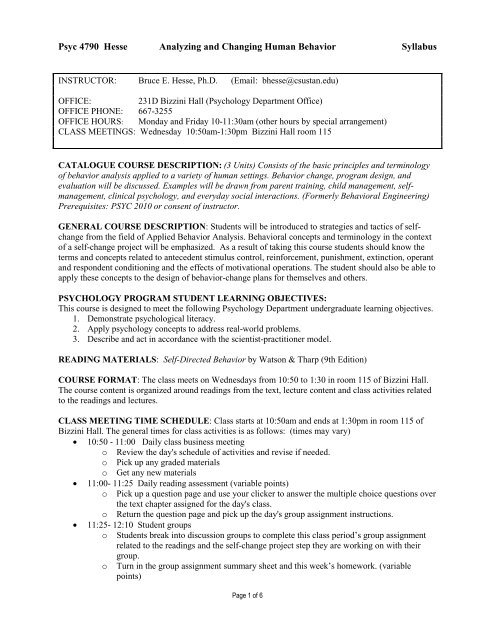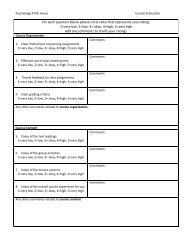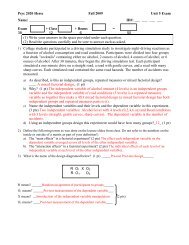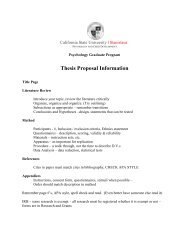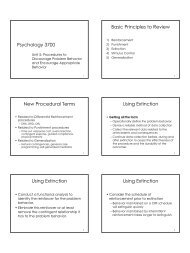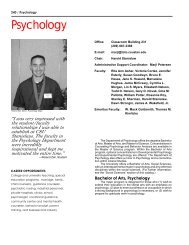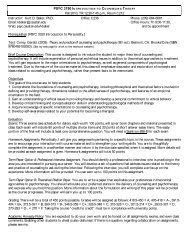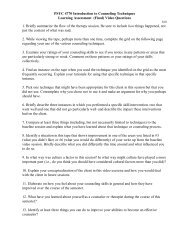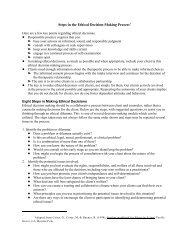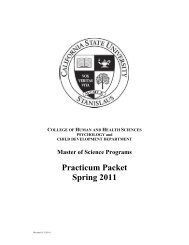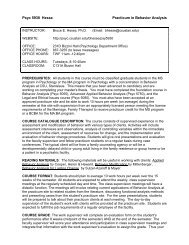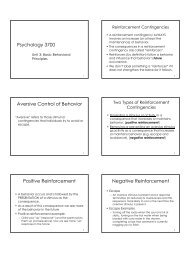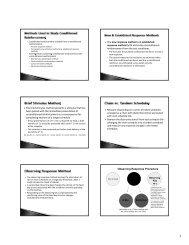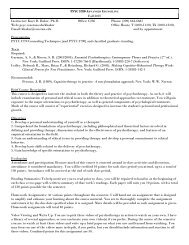Syllabus - Psychology and Child Development
Syllabus - Psychology and Child Development
Syllabus - Psychology and Child Development
You also want an ePaper? Increase the reach of your titles
YUMPU automatically turns print PDFs into web optimized ePapers that Google loves.
Psyc 4790 Hesse Analyzing <strong>and</strong> Changing Human Behavior <strong>Syllabus</strong><br />
INSTRUCTOR: Bruce E. Hesse, Ph.D. (Email: bhesse@csustan.edu)<br />
OFFICE:<br />
231D Bizzini Hall (<strong>Psychology</strong> Department Office)<br />
OFFICE PHONE: 667-3255<br />
OFFICE HOURS: Monday <strong>and</strong> Friday 10-11:30am (other hours by special arrangement)<br />
CLASS MEETINGS: Wednesday 10:50am-1:30pm Bizzini Hall room 115<br />
CATALOGUE COURSE DESCRIPTION: (3 Units) Consists of the basic principles <strong>and</strong> terminology<br />
of behavior analysis applied to a variety of human settings. Behavior change, program design, <strong>and</strong><br />
evaluation will be discussed. Examples will be drawn from parent training, child management, selfmanagement,<br />
clinical psychology, <strong>and</strong> everyday social interactions. (Formerly Behavioral Engineering)<br />
Prerequisites: PSYC 2010 or consent of instructor.<br />
GENERAL COURSE DESCRIPTION: Students will be introduced to strategies <strong>and</strong> tactics of selfchange<br />
from the field of Applied Behavior Analysis. Behavioral concepts <strong>and</strong> terminology in the context<br />
of a self-change project will be emphasized. As a result of taking this course students should know the<br />
terms <strong>and</strong> concepts related to antecedent stimulus control, reinforcement, punishment, extinction, operant<br />
<strong>and</strong> respondent conditioning <strong>and</strong> the effects of motivational operations. The student should also be able to<br />
apply these concepts to the design of behavior-change plans for themselves <strong>and</strong> others.<br />
PSYCHOLOGY PROGRAM STUDENT LEARNING OBJECTIVES:<br />
This course is designed to meet the following <strong>Psychology</strong> Department undergraduate learning objectives.<br />
1. Demonstrate psychological literacy.<br />
2. Apply psychology concepts to address real-world problems.<br />
3. Describe <strong>and</strong> act in accordance with the scientist-practitioner model.<br />
READING MATERIALS: Self-Directed Behavior by Watson & Tharp (9th Edition)<br />
COURSE FORMAT: The class meets on Wednesdays from 10:50 to 1:30 in room 115 of Bizzini Hall.<br />
The course content is organized around readings from the text, lecture content <strong>and</strong> class activities related<br />
to the readings <strong>and</strong> lectures.<br />
CLASS MEETING TIME SCHEDULE: Class starts at 10:50am <strong>and</strong> ends at 1:30pm in room 115 of<br />
Bizzini Hall. The general times for class activities is as follows: (times may vary)<br />
10:50 - 11:00 Daily class business meeting<br />
o Review the day's schedule of activities <strong>and</strong> revise if needed.<br />
o Pick up any graded materials<br />
o Get any new materials<br />
11:00- 11:25 Daily reading assessment (variable points)<br />
o Pick up a question page <strong>and</strong> use your clicker to answer the multiple choice questions over<br />
the text chapter assigned for the day's class.<br />
o Return the question page <strong>and</strong> pick up the day's group assignment instructions.<br />
11:25- 12:10 Student groups<br />
o Students break into discussion groups to complete this class period’s group assignment<br />
related to the readings <strong>and</strong> the self-change project step they are working on with their<br />
group.<br />
o Turn in the group assignment summary sheet <strong>and</strong> this week’s homework. (variable<br />
points)<br />
Page 1 of 6
Psyc 4790 Hesse Analyzing <strong>and</strong> Changing Human Behavior <strong>Syllabus</strong><br />
<br />
<br />
<br />
12:10 - 12:25 Short class break<br />
o Students may leave for snack or restroom needs or stay in the classroom.<br />
o The class instructor will be available for brief individual consultations.<br />
12:25 - 1:25 Course content presentation <strong>and</strong> discussion<br />
o Brief oral report of the group’s products from each group’s reporter.<br />
o Lecture on new material with class participation (clicker) points. (variable points)<br />
1:25 - 1:30 Daily wrap-up<br />
o Reminders of what is required for the next class meeting.<br />
o 1:30 -- Class dismissed<br />
STUDENT ASSESSMENT: Student progress will be assessed each class period with questions over<br />
assigned readings <strong>and</strong> with graded products from activities completed in <strong>and</strong> outside of class. The<br />
questions related to the reading assessments will be multiple choice but other assessments will involve<br />
short written products. Points will be summed to determine the course grade. Please refer to the course<br />
calendar for the schedule of reading assignments <strong>and</strong> homework assignments. There usually will be 20<br />
points available for each class period. Students must purchase a student response pad <strong>and</strong> register it online<br />
(www.einstruction.com ) using the class key on the registration instructions (see last page of this<br />
syllabus). Bring your response pad to each class to earn class related grade points. Your response pad<br />
must be the Gen2 or Pulse from eInstruction <strong>and</strong> have a small LCD screen. Other types of “clickers”<br />
will not work in this class.<br />
COURSE POLICIES<br />
GRADE: The course grade is derived from the percent of points earned during the semester as follows<br />
(rounded to the nearest whole percentage point):<br />
A =90%-100% B =80%-89% C =70%-79% D =60%-69%<br />
A grade report will be available on the class web site. It will show the student's cumulative points<br />
(accessed with the last 5 digits of the student's ID number), the total points after each class, the student's<br />
average point earnings per class <strong>and</strong> the average needed from the remaining classes to get a grade of A , B<br />
or C. Summary graphs of class grade distributions will also be provided once per week.<br />
REGRADE POLICY: Students may ask for clarification <strong>and</strong>/or regrading of an assessment activity if<br />
they feel an error was made or that the points received were not representative of the quality of the<br />
product they submitted for evaluation. A regrade request involves the following:<br />
1. the reasons why the assessment should be scored differently <strong>and</strong><br />
2. references to other materials to support these reasons.<br />
3. the regrade request must be written (an oral elaboration is acceptable if the main points are noted<br />
in writing) <strong>and</strong> turned in with the assessment to be regraded.<br />
EXTRA CREDIT: Students can earn a total of 6 extra credit points in this class for the following<br />
activities:<br />
1) Participate in a research project being conducted by either a graduate or an undergraduate student<br />
who has their project registered with the online (http://csustan.sona-systems.com) <strong>Psychology</strong><br />
Department research participant pool. Each credit earned in an experiment is worth 1 extra credit<br />
points.<br />
2) Individuals who choose not to participate in a research project can earn the extra credit points by<br />
reading <strong>and</strong> summarizing an article from an APA style <strong>Psychology</strong> research journal (2 points per<br />
summary). Before doing your summary, show the abstract of the article to the course instructor for<br />
Page 2 of 6
Psyc 4790 Hesse Analyzing <strong>and</strong> Changing Human Behavior <strong>Syllabus</strong><br />
approval. Turn in your typed summary by the remedial exam date. Your summary should include the<br />
following points: (two pages maximum)<br />
a) Complete reference for the article in APA format.<br />
b) The research question or issue that this article is addressing.<br />
c) The type <strong>and</strong> number of subjects used in this research (pigeons, rats, college students, children,<br />
developmentally disabled adults, etc.)<br />
d) The general procedure & design used in the method section (e.g. surveys, direct observations,<br />
independent groups, repeated measures, etc.)<br />
e) The general results <strong>and</strong> conclusions (usually found in the first or last part of the Discussion<br />
section).<br />
ATTENDANCE <strong>and</strong> REMEDIAL EXAM: You are expected to attend <strong>and</strong> participate in each class. If<br />
you miss a class you must contact the instructor or a fellow classmate to get what you missed. Most<br />
materials (if possible) will be posted on the class website. Absence from a student assessment activity<br />
will result in a loss of points for that activity. A comprehensive remedial exam will be given during the<br />
regularly scheduled final exam time period for this class during finals week. The score earned on the<br />
remedial exam will be used to replace two missed classes. If no classes were missed the remedial exam<br />
score can be used to replace the lowest two class scores. The remedial exam is optional. If you do not<br />
wish to replace any class points you are finished with the course after the last class.<br />
Please do not ask for make-up activities, plan to take the remedial exam to replace missed class points.<br />
CHEATING POLICY: If I have good evidence of any form of academic dishonesty (not doing your<br />
own work, plagiarizing the work of others or using fraudulent means to acquire grade points) I will fail<br />
you for the course, not allow you to attend further classes <strong>and</strong> send a memo to the Dean of the College of<br />
Human <strong>and</strong> Health Sciences <strong>and</strong> the chair of your major department detailing the evidence of the cheating<br />
episode.<br />
Page 3 of 6
Psyc 4790 Hesse Analyzing <strong>and</strong> Changing Human Behavior <strong>Syllabus</strong><br />
Course Calendar<br />
Class Date Topic<br />
Chapter<br />
#<br />
Pages<br />
Project<br />
Timeline<br />
Points<br />
1 2/1 Course Introduction None None None None<br />
2 2/8 Underst<strong>and</strong>ing Behavior 1 25 Goals #1 20<br />
3 2/15 Planning for Behavior Change 2 30 Goals #2 20<br />
4 2/22 Collecting the Critical Data 3 38 Measures #3 20<br />
5 2/29 Basic Principles in Behavior Analysis 4 12<br />
6 3/7 Basic Principles in Behavior Analysis 4 13<br />
B -> C<br />
#4a<br />
A -> B -> C<br />
#4b<br />
20<br />
20<br />
7 3/14<br />
Underst<strong>and</strong>ing the Antecedents to<br />
Behavior<br />
5 25<br />
Modifying<br />
Antecedents<br />
#5<br />
20<br />
8 3/21 Self-Change Behavior 6 30<br />
9 3/28 Consequences for Change 7 35<br />
Self-change<br />
Tactics #6<br />
Self-Change<br />
Tactics #7<br />
20<br />
20<br />
10 4/4<br />
Writing a Successful Behavior Change<br />
Plan<br />
8 25<br />
Final plan<br />
with data #8<br />
20<br />
11 4/18 Modifying Behavior Change Plans 9 24<br />
12 4/25 Maintaining Behavior Change Plans 10 19<br />
Adjustments<br />
to plan #9<br />
Planning for<br />
the future #10<br />
20<br />
20<br />
13 5/2<br />
Self-Change Project Presentation & Paper<br />
Instructions<br />
None<br />
Presentation<br />
grade form<br />
20<br />
14 5/9<br />
Finish Presentations Remedial Exam<br />
Instructions<br />
Final<br />
paper<br />
due<br />
None<br />
Paper grade<br />
form<br />
20<br />
Page 4 of 6
Psyc 4790 Hesse Analyzing <strong>and</strong> Changing Human Behavior <strong>Syllabus</strong><br />
Class Name: Psyc 4790 Class Key: N71419M853<br />
You will need:<br />
Class Key (N71419M853)<br />
Connection to the Internet<br />
Method of Payment (Credit card or personal check)<br />
Enrolling through CPSOnline<br />
You will first need to setup a CPSOnline account.<br />
Create a CPSOnline Account<br />
1. Go to www.einstruction.com <strong>and</strong> click on the CPS Online Login link at the top right of<br />
the webpage or click on the picture of the response pad on the class web page (left side<br />
under response pad instructions).<br />
2. Select California State University, Stanislaus from the drop-down menu.<br />
3. Click Choose Site.<br />
4. Enter your serial number in the space provided. You can find your serial number on your<br />
LCD screen when you turn on your response pad: if your pad does not have an LCD<br />
screen, you have the wrong response pad.<br />
5. Click Create Your Account.<br />
6. Create a CPSOnline Username <strong>and</strong> Password <strong>and</strong> fill in your contact information (use the<br />
last 5 digits of your Student ID number only as your student ID). Click Submit to create<br />
your account.<br />
You’ve now created a CPSOnline account. You can use your CPSOnline username <strong>and</strong> password<br />
to login anytime to CPSOnline. Now you can enroll your pad in your class.<br />
Enroll in a Class<br />
1. Click Yes to enroll immediately in your class.<br />
2. Enter your Class Key N71419M853 in the space provided. You do not have a code so<br />
leave the code box blank.<br />
3. Click Submit <strong>and</strong> choose your payment options. Click Continue.<br />
4. Fill in your billing information <strong>and</strong> click Continue.<br />
5. To join an additional CPSOnline class, click the Enroll in a class button from the main<br />
menu.<br />
6. Once you have finished enrolling in all of your classes, click Log Out. So that<br />
CPSOnline properly records your information, log out of CPSOnline.<br />
NOTE: If you enroll in more than one class using CPS, your response pad may have a different<br />
assigned number for each class. Note your assigned response pad number after you enroll for<br />
each class, <strong>and</strong> use the reminder emails from eInstruction to keep track of your information.<br />
Page 5 of 6
Psyc 4790 Hesse Analyzing <strong>and</strong> Changing Human Behavior <strong>Syllabus</strong><br />
Using your Response Pad in your class<br />
The eInstruction response pad is easy to use with CPS. Use the information below to learn how<br />
to use the buttons on the pad. If you have any questions, log onto www.einstruction.com <strong>and</strong> use<br />
the Customer Support menu option. Type in your name <strong>and</strong> enter the live chat room for<br />
immediate help. You can also reach Technical Support at 888.333.7532.<br />
Power – turn the response pad on or off by pressing the PWR/JOIN button.<br />
Join – the response pads automatically search for a class roster to join whenever you turn<br />
on the pad.<br />
• Initiate Join – to have the response pad begin searching for a class roster to join, turn<br />
on the response pad <strong>and</strong> press the PWR/JOIN button.<br />
• Manually Join – to manually join a class, turn on the response pad <strong>and</strong> press the<br />
PWR/JOIN button twice. Join: appears on the LCD screen. Type in the channel<br />
number for the class roster you would like to join, <strong>and</strong> press Send.<br />
Use Negative Numbers – make a numeric response positive or negative by pressing the<br />
+- button.<br />
Enter Equations – create equations by entering symbols into your response with the<br />
Sym button. You can include the following symbols: X, Y, =, ( ), . (decimal), + (plus<br />
operator), - (minus operator), / (division operator), * (multiplication operator), (space)<br />
View Response Pad Information – to view the response pad channel, roster number,<br />
<strong>and</strong> firmware version, turn the pad on <strong>and</strong> press the < button.<br />
View Serial Number – to view the serial number for your response pad, simply press the<br />
PWR/Join button to turn on the response pad. The serial number displays in the LCD<br />
screen as your response pad searches for a class roster to join. Your serial number will<br />
begin with “r1…”.<br />
Adjust LCD Screen Contrast – to adjust the LCD screen contrast, press the > button.<br />
Use the A1 button to decrease the contrast <strong>and</strong> the C3 button to increase contrast.<br />
Page 6 of 6


